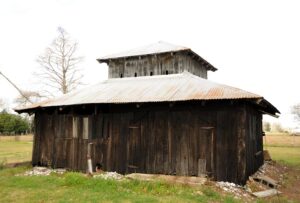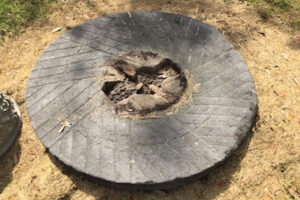
This aviary was used to house pigeons and they may have been used for various purposes. Pigeons have been used throughout the entire world since the time of the ancient Mesopotamians for racing, message deliveries, plumage and manure for crops and finally food.
Notice the openings at the top that allowed pigeons to come and go as they pleased without worrying about predators getting them on the ground. This may indicate they might have been carrier pigeons or pigeons used in wartime.

The ecology in Terrebonne Parish, Louisiana was not conducive to most grain crops such as wheat and rice and the only grain crop that was easily grown and very productive in the 1800s was corn. Volumnia Farm has the millstones used on the farm during the 1800s to make corn flour, corn meal and grist.
Cornbread or grist were eaten at every meal and were a principal part of the diet as rice and bread are today. Millstones always come in pairs called the bedstone or bottom stone that does not turn and the runner stone that turns on the top. The stones have grooves cut into them and the grain is fed into the center the runner stone turns and the grain is cut between the two stones and the groves slowly move the grain outward.
The Dutch used wind powered windmills to turn the stones. In New England water powered water wheels were used. However, in South Louisiana in the 1800s horses and mules had to be used to turn the stones due to the slower moving bayous.















































